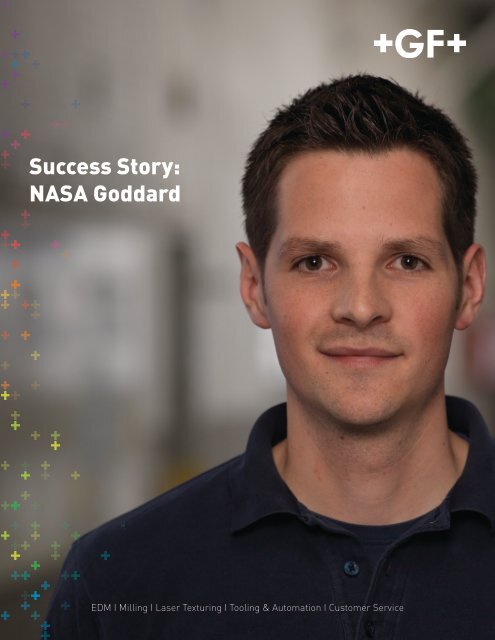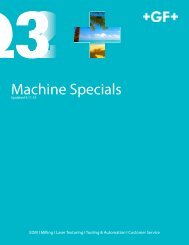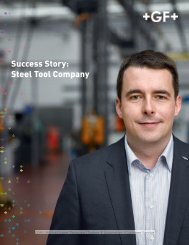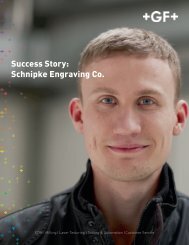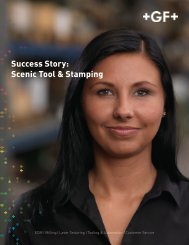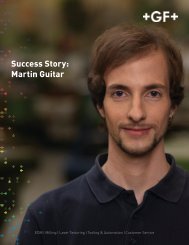NASA Goddard
Create successful ePaper yourself
Turn your PDF publications into a flip-book with our unique Google optimized e-Paper software.
Success Story:<br />
<strong>NASA</strong> <strong>Goddard</strong><br />
EDM I Milling I Laser Texturing I Tooling & Automation I Customer Service
Nobody flies without manufacturing – how the Advanced<br />
Manufacturing Branch at <strong>NASA</strong>’s <strong>Goddard</strong> Space Flight Center<br />
is helping to push the limits of space technology.<br />
When it comes to advancing space exploration, the sky’s the<br />
limit at <strong>NASA</strong>’s <strong>Goddard</strong> Space Flight Center (GSFC), a place<br />
where studying black holes, conducting gravitational mapping<br />
of the moon, exploring Mars and Jupiter, and visiting the<br />
International Space Station propel science beyond what was<br />
ever thought possible.<br />
Located in Greenbelt, Md., the GSFC designs, builds, and operates<br />
satellites and scientific equipment such as the Hubble<br />
Space Telescope, GOES weather satellites, LandSat earth imaging<br />
systems, the SOHO solar observatory, and many others.<br />
A big part of the GSFC’s capabilities comes from its on-site<br />
Advanced Manufacturing Branch, which provides broad machining,<br />
fabrication, and assembly services via punches and<br />
press brakes, gauging systems, turning machines, and GF<br />
AgieCharmilles multi-axis high-speed machining centers. And<br />
with in-house metal finishing, composite layup and curing,<br />
rapid prototyping, precision assembly, and more, there’s not<br />
much the branch can’t handle.<br />
Matt Showalter, associate branch head for the Advanced<br />
Manufacturing Branch, code 547, often thinks of the facility as<br />
<strong>Goddard</strong>’s “temple of science and engineering.” He said, “It’s<br />
a place for ideas to become reality. The branch’s motto, based<br />
on an old advertising logo, is “we bring concepts to flight.”<br />
For nearly a decade, Showalter has been part of a team devoted<br />
to continuous improvement of <strong>Goddard</strong>’s manufacturing<br />
abilities. Showalter explained, “Our purpose here is to ensure<br />
that we have the capability and capacity to do anything that<br />
comes through the door. Prior to our initiative to modernize<br />
the shop, we were totally dependent on older systems and<br />
there were some things we just couldn’t do. You can limit<br />
yourself from a science and engineering perspective if you<br />
don’t put new technologies into your manufacturing.”<br />
Before the modernization initiative was begun at <strong>Goddard</strong> nine<br />
years ago, one missing piece of the manufacturing puzzle was<br />
multi-axis high-speed machining. To that end, the Advanced<br />
Manufacturing Branch team has invested in Mikron multiaxis<br />
machining centers from GF AgieCharmilles. Starting with<br />
one Mikron HSM 600U machine seven years ago, the facility<br />
now has an impressive 4-machine high-speed machining cell<br />
containing the original HSM 600U together with a Mikron HSM<br />
400U, Mikron HPM 800U and Mikron HPM 1350U.<br />
Showalter explained that bringing in new machine tool technology<br />
is a collaborative effort, controlled by strict federal<br />
procurement regulations, where potential vendors are invited<br />
in to show off their wares. Beginning with discussions about<br />
future needs of the engineers and scientists, and technical<br />
assessments by technicians from the shop floor, everyone<br />
contributes in developing the statement of work that defines<br />
the specifications for the necessary machine technology to<br />
meet the current and future requirements of the organization.
It’s not just a piece of equipment, but a complete package of<br />
support, tooling, and training. “When it hits the floor, we want<br />
it running and not waiting three years to tool it up.”<br />
Today’s satellites and associated instruments are getting<br />
lighter and smaller, with modern satellites coming in at onefourth<br />
the size of their older cousins. “We have to minimize<br />
weight, because it’s expensive to launch. As part features<br />
get smaller, our tolerances get smaller as well. And the high<br />
speed machining centers are critical to this work.”<br />
With the capability of Mikron High Speed Machining (HSM) and<br />
High Performance Machining (HPM), the Advanced Manufacturing<br />
Branch is able to handle a variety of work. “We machine<br />
anything from aluminum, titanium, Inconel, Invar, stainless<br />
steel, and high-nickel alloys…you name it.” From these<br />
materials, the Advanced Manufacturing Branch employees<br />
use the Mikrons to machine an expansive range of workpiece<br />
types, from components measuring .030” across with features<br />
as small as a human hair, all the way up to workpieces that<br />
would fill a one-meter cube.<br />
Designed to accommodate workpieces up to 9.05” x 13.77”, the<br />
Mikron HSM 400U portal design provides simultaneous 5-axis<br />
machining in a compact footprint. Because of its reliability,<br />
traceability and accuracy, the Mikron HSM 400U is an ideal<br />
solution for the Advanced Manufacturing Branch’s prototype<br />
work and mold construction. Additionally, the machine<br />
provides excellent surface finishes and precision part details,<br />
while significantly reducing machining time for semi-finishing<br />
and finishing operations.<br />
The Mikron HSM 600U and Mikron HPM 800U are also based<br />
on a portal-type gantry design. These 5-axis machines are<br />
built for high-performance machining applications, and for 100<br />
percent full 5-axis simultaneous machining operations, the<br />
two machines feature direct drives in their circular and swiveling<br />
axes, which securely clamp in place for precision part<br />
positioning. Thanks to their unique designs and modularity,<br />
these machines provide the Advanced Manufacturing Branch<br />
with high-accuracy machining for both its single part production<br />
and rational series production.<br />
GF AgieCharmilles’ Mikron HPM 1350U, on the other hand,<br />
is based on a cross-bed-type design. The machine’s frameshaped<br />
traveling column moves the spindle in the Y- and<br />
Z-axis travels, while the X-axis is in the table. This special<br />
design allows the Advanced Manufacturing Branch to eliminate<br />
problems associated with any superimposed machine<br />
movements.<br />
But there’s more to the story than high-performance and<br />
high-speed machining. The multi-axis capabilities of the Mikrons<br />
can allow <strong>Goddard</strong> engineers to design better parts. Said<br />
Showalter, “With the 5-axis system, we have the ability to take<br />
a multiple-component bracket or assembly configuration and<br />
make it into one part. We can go from plane normal to a reverse<br />
angle plane or compound angle plane and do everything<br />
in one workpiece and a single operation. So instead of stacked<br />
tolerances (as in a multiple-part assembly), our accuracies<br />
are controlled by a single reference coordinate system.”<br />
One of the people using the Advanced Manufacturing Branch’s<br />
services is Adam Matuszeski, electromechanical engineer at<br />
<strong>NASA</strong>. Matuszeski was part of the group responsible for building<br />
the Lunar Reconnaissance Orbiter, or LRO, which was<br />
placed into orbit around the Earth’s moon in 2009. Designed to<br />
map out potential landing sites and gather information about<br />
the moon’s surface and geography, the LRO mission, slated to<br />
last only 14 months, is still successfully streaming data back<br />
to <strong>Goddard</strong>.<br />
Circling the moon at an altitude of 30 miles, the LRO satellite<br />
carries seven high-tech devices designed to image the moon’s<br />
surface, measure radiation levels, and look for areas of frost<br />
and water ice, especially near the poles. Critical to the LRO’s<br />
success is always knowing the precise location of the spacecraft.<br />
To accomplish this feat, scientists mounted a small telescope<br />
on the orbiter’s antenna dish. Said Matuszeski, “The telescope<br />
looked through a hole in the dish, and was connected via fiber<br />
optics from the back of the telescope to a detector on the<br />
laser altimeter. Because it was going to the moon and taking<br />
very precise instrument data, it needed to have a way of knowing<br />
exactly where in space it was.”<br />
The solution was a tiny telescope hidden behind the antenna<br />
dish and designed to give a laser-referenced measurement<br />
from earth. It picks up a pulse of green laser light shot from a<br />
station at Greenbelt and measures the amount of time it takes<br />
to get from the earth to the LRO, indicating how far away the<br />
spacecraft is from earth.”<br />
“For this project, we had to run seven 0.25 mm diameter fiber<br />
optics across the spacecraft. The trickiest part of that was<br />
machining the tip of the connector, which is called the ferrule.<br />
It’s a 2.5 mm cylinder that’s hollow on one side, like a long<br />
thin cup about 17 mm long. We milled a flower-shaped pattern<br />
in the end of the cup using a .006”end mill on our Mikron<br />
machine, which allowed us to locate those seven fibers, six on<br />
the outside and one in the middle, then affix them there with<br />
an epoxy and polish them flat,” explained Matuszeski. With the<br />
LRO, <strong>NASA</strong> has already collected the same amount of data as<br />
all previous planetary missions combined.<br />
Another of the seven devices riding aboard the LRO is LOLA,<br />
short for the Lunar Orbiter Laser Altimeter. LOLA is a complex<br />
little device, but in simple terms, her job is to generate a<br />
high-resolution 3D map of the moon, which will help scientists<br />
find the best place to land future spacecraft, or possible<br />
sites for solar power stations.<br />
“LOLA uses what’s called a LIDAR. It’s like a radar, but it uses<br />
a laser for detection and ranging to measure distance,” said<br />
Matuszeski. “However, the art of creating a laser that can fly<br />
in space is kind of a black art, and it’s one of the things that<br />
our center at <strong>Goddard</strong> prides itself on. We’ve probably done<br />
five or six of them successfully over the last 15 to 20 years, and<br />
all of them were challenging.”<br />
Matuszeski went on to say that it’s quite difficult to build a<br />
laser that will last years in space, not only because of the
harsh environment, but also because it’s impossible to make<br />
any physical adjustments after the device has left the launching<br />
pad.<br />
To accomplish its difficult mission, LOLA depends on a tiny<br />
array of five fiber-optic lenses held in a precision-machined<br />
ferrule. LOLA fires a laser beam through this optical array,<br />
where it is broken into five separate beams, each of which<br />
bounces off the moon’s surface before returning to LOLA and<br />
being transmitted back to earth, thus allowing scientists to<br />
measure the surface variations and piece together a 3D map<br />
of the lunar surface.<br />
Matuszeski explained that the five fiber optics — each just 0.1<br />
mm in diameter — were precisely placed in a cross pattern<br />
on the back of the telescope. “It kind of looked like the cross<br />
section of a clover leaf or club from a deck of cards. We were<br />
trying to machine that shape into a stainless steel ferule 2.5<br />
mm across.”<br />
He further explained, “All five of them had to be located within<br />
respect to the center of the pattern within 10 to 15 microns.<br />
The holes had to be slightly more precise than that, because<br />
otherwise the fibers could move around and get bonded in<br />
the wrong place. We used a 0.003” end mill running at up to<br />
36,000 rpm, and looked at the tool after every cut to check for<br />
wear. We’d then adjust the next cut based on that. I don’t think<br />
we could’ve done these particular parts on any other machines<br />
than a highly accurate 5 axis machining center.”<br />
It’s tough machining work, to be sure. So why not outsource<br />
it? With today’s budget-cutting economy, wouldn’t it be easier<br />
and cheaper just to send this work out to a job shop, someone<br />
who specializes in this sort of work? Said Showalter, “In fact,<br />
the majority of the work that we do goes outside to our vendors.<br />
But what I see as different from a job shop is that we’re<br />
here to produce a part, sure, but we’re also here to figure out<br />
the process. That’s why we keep a lot of the tougher work inhouse.<br />
When you’re doing internal research and development<br />
or solving critical tolerance issues for a flight project, it gives<br />
you in-house control and feedback in real time for the development<br />
of that process.”<br />
That’s because, aside from high-precision and high-performance<br />
machinery and the knowledge to operate it, building<br />
a spacecraft also requires a high level of collaboration. Said<br />
Showalter, “We look at this as a triangle — science, engineering<br />
and manufacturing. You need science for the ideas of what<br />
you’re going to do. Engineering determines the designs for the<br />
hardware. But, nobody flies without manufacturing. There are<br />
three legs to the stool.”<br />
According to Showalter, “At times we’ll go back to the machine<br />
and cutting tool vendors to get their input. We don’t<br />
pretend to be the expert on everything. That’s why we collaborate<br />
with the organizations that sell us the equipment. We<br />
don’t want to go in and just buy a machine. The most value<br />
to us, the government, is the full package: is it the correct<br />
manufacturing technology, what does the machine cost, what<br />
does the training cost, are application engineers available<br />
when needed?”<br />
These factors are important because the facility’s schedules<br />
are critical. When dealing with celestial events, there may<br />
be times there’s only one chance for success. “For instance,<br />
if we’re involved in a project specific to a comet fly by, for<br />
example, such an event may not have occurred in hundreds of<br />
years. So when we are involved with such once-in-a-lifetime<br />
events, meeting specified launch dates is mandatory. To do<br />
so, we’ll use all the resources available to us, including our<br />
machine tool suppliers.”<br />
“After the new machines were installed, GF AgieCharmilles<br />
came out and had both machines up and running in less than<br />
10 days. Training began. We were bringing new folks into the<br />
cell. Because of that, we made calls and had applications support<br />
quickly queued up and on the phone whenever we needed<br />
it.”<br />
Showalter said that level of support continues today, “We had<br />
a job that was kind of rushed and we needed support, and they<br />
sent an applications engineer out who was on site within 48<br />
hours. Considering we had three new guys coming into that<br />
group, that’s pretty good. Pretty much, that’s the standard.<br />
Anything we put on the floor, the expectation is that’s what we<br />
want, and AgieCharmilles is quite aware of what we need, so<br />
they deliver it and meet our expectations every time.”<br />
“Overall, GF AgieCharmilles is a very responsive technical<br />
collaborator and has played a vital role for us,” commented<br />
Showalter. “We are looking to make <strong>Goddard</strong> a world-class,<br />
premiere manufacturing facility. That said, as the technology<br />
grows, we intend to grow with it. The days of buying a piece of<br />
equipment and keeping it for 25 years until its dead are gone.”<br />
With the rapid change of technology, it’s important that the<br />
facility can update the equipment at the end of its useful life.<br />
Bill Cowan, sales associate with Tuckahoe, the GF<br />
AgieCharmilles Sales Agent that supplied the Mikron equipment<br />
to <strong>Goddard</strong>, supports that statement. “Something that’s<br />
different here than in a lot of other government facilities is<br />
this: machines at <strong>Goddard</strong> are being utilized more consistently<br />
than what I see in a lot of private shops. <strong>Goddard</strong> works as<br />
teams that are all on campus, so production times are shorter<br />
and operations more efficient with less waste.”<br />
For over 50 years, the U.S. space program has been making<br />
important scientific discoveries, providing the raw stuff of high<br />
technology. It’s not just about putting people in space. Aside<br />
from the obvious benefits of space technology — global positioning<br />
systems, weather monitoring, and telecommunication<br />
satellites, to name a few — there are also the everyday items<br />
often taken for granted: athletic shoes, water purification,<br />
smoke detectors, invisible braces, instant-read thermometers,<br />
even pizza delivery boxes and golf-ball dimples. The list<br />
goes on, and will continue to grow as <strong>NASA</strong> and the talented<br />
people at the <strong>Goddard</strong> Space Flight Center continue to push<br />
the limits.
GF Machining Solutions<br />
GF Machining Solutions<br />
560 Bond Street<br />
Lincolnshire, IL, 60069<br />
USA<br />
Website: www.gfms.com/us<br />
Email: info.gfms.us@georgfischer.com<br />
Phone: 847-913-5300<br />
© Machining Solutions, 2015<br />
The technical data and illustrations are not binding.<br />
They are not warranted characteristics and are<br />
subject to change.<br />
Facebook: facebook.com/gfmachiningsolutions<br />
Twitter: twitter.com/gfms_us<br />
YouTube: youtube.com/agiecharmilles<br />
Version 1.1


